Nicholas Thorne's Family History Pages.
Second port of call was to find Cuttlehill House, in the parish of Aberdour.
From the
Proclamations of banns and marriages Jeanette and Charles actually married at
her late father's house Cuttlehill House.
Back in the car I consulted my map. It seemed to me that Cuttlehill was actually
near the town of Crossgates to the North of Aberdour.
I set off and spent hours trying to find the correct road out of Crossgates. I kept getting lost and then found a sign for Aberdour only 3 miles away! By this time I had driven twenty or so miles in every direction until on one pass down a road I spotted a sign for a Cuttlehill Farm. Was this it, I wondered?
I turned and drove back and pulled off the road. I was looking at a long driveway going up to some farm buildings and it looked pretty private to me.
There were, however, no signs saying “Keep Out” or “Sassenachs Will Be
Strung Up If They Dare Enter”
I took this lack of any signs as being positive and as I had come all this way
I could not give in to my normal inclination not to impose myself on anyone
or, indeed, their land. My grandmother would have been proud of me! As
a boy her hand was often felt in the small of my back pushing me forward into
places or situations I did not wish to go and now here I was boldly driving
up some farmer's drive way in the search of her grandparent's wedding venue
at her grandmother's family home.
At the top of the track were some very old sandstone buildings that looked like stables, a modern barn with a tractor parked and a sliver haired man working on it. A Citroen Picasso was also drawn up with, I was shortly to find out, the farmer's wife sitting in it and a young man in a fearsomely large tractor manoeuvring in the yard. I stopped the car and wondered if they were friendly. None of the three came over to me with a pitch fork, or even a stern face, so I got out and approached them.
“Excuse my cheek at coming onto your property like this,” I began,“but
I noticed it was called Cuttlehill Farm and while researching my family history
I found that an ancestor of mine lived at Cuttlehill House. Could you tell me
if it is still standing?”
The farmer, who had been working with a wrench on the implement on the back of the parked tractor smiled at me and answered me in a warm tone. He told me that the house had all but gone except for the foundations which were still to be seen in the field just a few yards from where we stood.
“If you like I'll walk down with you and show you.” he offered.
What friendly people!
 |
Was
this Cuttlehill? No! |
|
 |
Fifeshire countryside near Cuttlehill |
|
 |
Is
this Cuttlehill? No! |
|
 |
At Last! Cuttlehill Farm today.2006 |
|
 |
All that remains of Cuttlehill House |
|
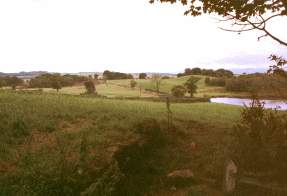 |
Towards
the Forth and Edinburgh on the horizon. |
|
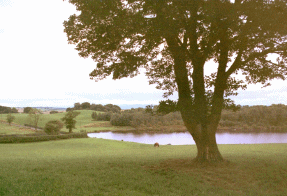 |
Cuttlehill woods + pond from house site. |
|
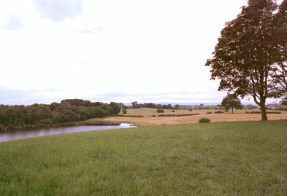 |
Cuttlehill House aspect looking south west. |
|
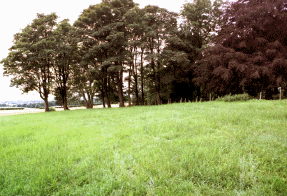 |
The grass area, footprint of Cuttlehill house |
|
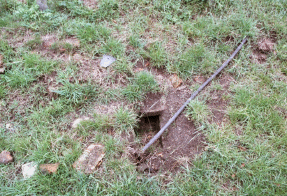 |
Bricks are still being ploughed up today. |
|
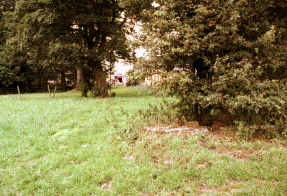 |
Back of the house, carriage house in distance |
|
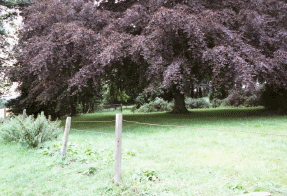 |
Back of the house with carriage way. |
|
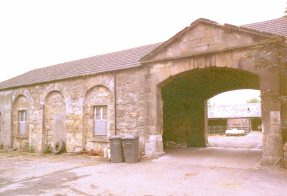 |
The
stable block and Carriage house. |
|
 |
Farm yard on other side of stables. |
|
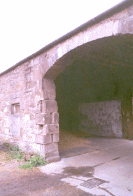 |
Stables
and Carriage house. |
|
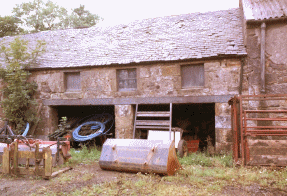 |
Ancient building at Cuttlehill farm |
|
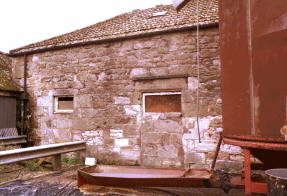 |
In the yard. |
|
Three days in Scotland, August 2006
.gif) |
Cuttlehill House (Front) |
|
His wife joined in the conversation and they started to tell me all about the place. They were now its owners, having been tenant farmers for years of British Coal. The land had been in the ownership of the National Coal Board, which became British Coal, before they had a chance to buy it.
All the coal mines have now gone and there is no trace of the industry today, but he could show me where the wheels and shafts had been on my map of the house and grounds.The present owners were very interested in the history of their land and were intending to find out more from the present day Wemyss estate about when the last Wemyss lived there.
What they did know, from their deeds, was that a William Wemyss sold the land
to the Coal Board. Coal mining, it seems, had taken place in the area for years
gone by. Firstly by a private company run by the Henderson family. Sir John
Henderson, laird of Fordell, who had mines on the neighbouring land, had made
a bargain with Mr Wemyss, laird of Cuttlehill, to mine coal on the Cuttlehill
estate at the end of the 1700s.
The Wemyss family were very much into coal mining themselves, although more around the town and area that takes their name further up the coast. They had a private railway for their coal with WPR or Wemyss Private Railway on the side! What relationship these were to our William Wemyss of Cuttlehill and Whitelaw, I shall no doubt research in the future.
Taking me down to the field to see the ruined foundations, the farmer showed me where the door would have been, where the carriages would have driven down to the house from the stable block, which are still standing today and used as part of his farm.
He showed me the Monkey-puzzle trees that he assumes would have been planted when the house was there and where the garden would have been. He told me that others tell tale of the house as a ruin before the second world war and its bricks and stone would have been used for construction of other properties elsewhere and that is why so little remains.
Meanwhile, his wife went off to their farmhouse to look out and photocopy for me a picture that some people had sent them from America.
As I understood it, another family had farmed the land as tenant farmers before
emigrating to the United States at the end of the 19th century. They had taken
with them a watercolour of Cuttlehill House, to America. A second drawing had
been done in 1912 from a photograph as a “High School Project” by one of the
couple's grandsons, in the U.S.A. This was of the back of the house and a photocopy
was also offered to me by the present owners.
In 1976 another grandson, of the emigrants, came visiting looking for where
his grandmother had once farmed and, on his return to America, sent the original
photocopies. These very friendly people, who now own the land, were only too
please to offer me copies to keep. All in all I was with them for perhaps three
quarters of an hour talking about the land and area. They were happy to allow
me to wander about and photograph the remaining buildings, the foundations and
the fantastic aspect that Cuttlehill house must once have enjoyed.
.gif) |
Cuttlehill House (Rear) |
|